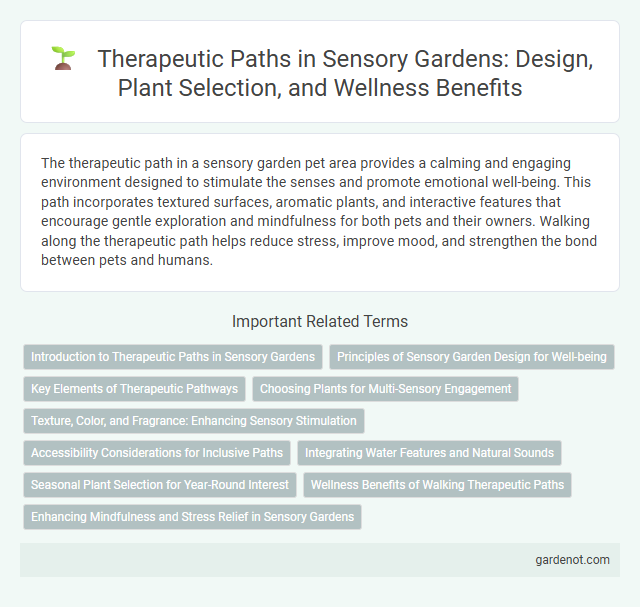The therapeutic path in a sensory garden pet area provides a calming and engaging environment designed to stimulate the senses and promote emotional well-being. This path incorporates textured surfaces, aromatic plants, and interactive features that encourage gentle exploration and mindfulness for both pets and their owners. Walking along the therapeutic path helps reduce stress, improve mood, and strengthen the bond between pets and humans.
Introduction to Therapeutic Paths in Sensory Gardens
Therapeutic paths in sensory gardens are designed to stimulate multiple senses, promoting physical and mental healing through carefully arranged textures, scents, and visual elements. These paths encourage mindful walking and sensory engagement, helping individuals reduce stress, improve mood, and enhance motor skills. Integrating features like aromatic plants, textured surfaces, and calming sounds creates an immersive healing environment tailored to diverse therapeutic needs.
Principles of Sensory Garden Design for Well-being
Therapeutic paths in sensory gardens are designed based on principles that promote holistic well-being through multi-sensory engagement, incorporating textures, scents, colors, and natural sounds to stimulate the senses. These pathways prioritize accessibility, safety, and comfort, ensuring users experience a calming environment that encourages mindfulness and stress reduction. Strategic plant selection and layout foster therapeutic benefits by enhancing emotional balance, cognitive function, and physical rehabilitation.
Key Elements of Therapeutic Pathways
Therapeutic pathways in sensory gardens incorporate key elements such as varied textures, aromatic plants, and natural sounds to engage multiple senses and promote relaxation. Thoughtfully designed routes include tactile surfaces like gravel or smooth wood, alongside sensory stations featuring fragrant herbs or wind chimes to enhance mindfulness and reduce stress. These elements encourage physical activity and cognitive stimulation, supporting emotional well-being and rehabilitation.
Choosing Plants for Multi-Sensory Engagement
Selecting plants with diverse textures, scents, and colors enhances the therapeutic path by stimulating multiple senses simultaneously. Incorporating aromatic herbs like lavender and rosemary, along with textured foliage such as lamb's ear and ornamental grasses, encourages tactile and olfactory interaction. Brightly colored blooms like echinacea and coneflowers add visual appeal, creating a rich, multi-sensory garden experience for healing and relaxation.
Texture, Color, and Fragrance: Enhancing Sensory Stimulation
The therapeutic path in a sensory garden is designed to stimulate touch, sight, and smell through diverse textures, vibrant colors, and fragrant plants. Soft moss, rough bark, and smooth stones engage tactile senses, while bright flowers and contrasting foliage enhance visual appeal. Aromatic herbs and blossoms such as lavender and jasmine provide soothing scents that promote relaxation and mental well-being.
Accessibility Considerations for Inclusive Paths
Therapeutic paths in sensory gardens prioritize accessibility by incorporating smooth, non-slip surfaces and gentle gradients to accommodate wheelchairs and mobility aids. Tactile markers and clear signage with braille enhance navigation for individuals with visual impairments. Wide pathways ensure comfortable passage for caregivers and visitors, fostering an inclusive environment that supports physical and sensory engagement for all users.
Integrating Water Features and Natural Sounds
Therapeutic paths in sensory gardens enhance healing by integrating water features and natural sounds, which stimulate multiple senses and promote relaxation. Flowing water elements like fountains or streams create calming auditory stimuli, while the gentle murmur masks urban noise, reducing stress. Combining these with native bird calls or rustling leaves creates a soothing multisensory environment that supports mental well-being and sensory engagement.
Seasonal Plant Selection for Year-Round Interest
Selecting seasonal plants in a therapeutic sensory garden enhances year-round engagement by providing diverse textures, colors, and scents that stimulate the senses. Incorporating native perennials, flowering shrubs, and aromatic herbs ensures continuous sensory variation and supports local biodiversity. Careful planning of bloom cycles and foliage changes creates dynamic therapeutic experiences that adapt to every season.
Wellness Benefits of Walking Therapeutic Paths
Walking therapeutic paths in sensory gardens stimulates multiple senses, promoting mental clarity and reducing stress through natural engagement. These paths enhance physical wellness by encouraging gentle exercise, improving circulation, and boosting mood via exposure to nature's calming elements. Regular use supports emotional healing and mindfulness, making sensory garden therapeutic paths integral to holistic health.
Enhancing Mindfulness and Stress Relief in Sensory Gardens
Therapeutic paths in sensory gardens integrate natural textures, scents, and sounds to stimulate mindfulness and promote stress relief. By engaging multiple senses, these paths encourage visitors to focus on the present moment, reducing anxiety and enhancing emotional well-being. Incorporating elements such as fragrant herbs, textured stones, and gentle water features maximizes calming effects and supports holistic mental health benefits.
Therapeutic path Infographic

 gardenot.com
gardenot.com